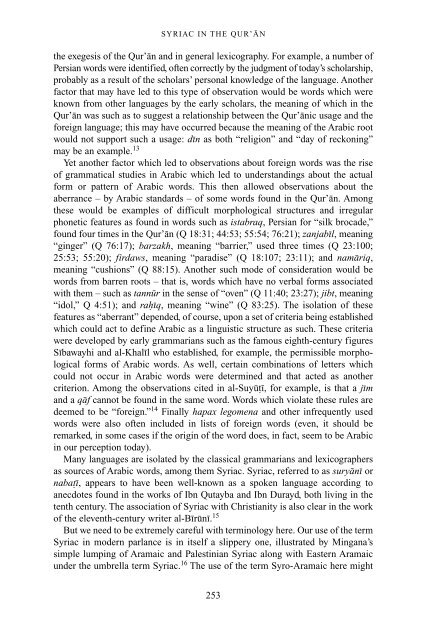The Qur'an in its historical context (pdf - Islam and Christian-Muslim ...
The Qur'an in its historical context (pdf - Islam and Christian-Muslim ...
The Qur'an in its historical context (pdf - Islam and Christian-Muslim ...
You also want an ePaper? Increase the reach of your titles
YUMPU automatically turns print PDFs into web optimized ePapers that Google loves.
SYRIAC IN THE QUR’AN<br />
the exegesis of the Qur’an <strong>and</strong> <strong>in</strong> general lexicography. For example, a number of<br />
Persian words were identified, often correctly by the judgment of today’s scholarship,<br />
probably as a result of the scholars’ personal knowledge of the language. Another<br />
factor that may have led to this type of observation would be words which were<br />
known from other languages by the early scholars, the mean<strong>in</strong>g of which <strong>in</strong> the<br />
Qur’an was such as to suggest a relationship between the Qur’anic usage <strong>and</strong> the<br />
foreign language; this may have occurred because the mean<strong>in</strong>g of the Arabic root<br />
would not support such a usage: d<strong>in</strong> as both “religion” <strong>and</strong> “day of reckon<strong>in</strong>g”<br />
may be an example. 13<br />
Yet another factor which led to observations about foreign words was the rise<br />
of grammatical studies <strong>in</strong> Arabic which led to underst<strong>and</strong><strong>in</strong>gs about the actual<br />
form or pattern of Arabic words. This then allowed observations about the<br />
aberrance – by Arabic st<strong>and</strong>ards – of some words found <strong>in</strong> the Qur’an. Among<br />
these would be examples of difficult morphological structures <strong>and</strong> irregular<br />
phonetic features as found <strong>in</strong> words such as istabraq, Persian for “silk brocade,”<br />
found four times <strong>in</strong> the Qur’an (Q 18:31; 44:53; 55:54; 76:21); zanjabil, mean<strong>in</strong>g<br />
“g<strong>in</strong>ger” (Q 76:17); barzakh, mean<strong>in</strong>g “barrier,” used three times (Q 23:100;<br />
25:53; 55:20); firdaws, mean<strong>in</strong>g “paradise” (Q 18:107; 23:11); <strong>and</strong> namariq,<br />
mean<strong>in</strong>g “cushions” (Q 88:15). Another such mode of consideration would be<br />
words from barren roots – that is, words which have no verbal forms associated<br />
with them – such as tannur <strong>in</strong> the sense of “oven” (Q 11:40; 23:27); jibt, mean<strong>in</strong>g<br />
“idol,” Q 4:51); <strong>and</strong> rahiq, mean<strong>in</strong>g “w<strong>in</strong>e” (Q 83:25). <strong>The</strong> isolation of these<br />
features as “aberrant” depended, of course, upon a set of criteria be<strong>in</strong>g established<br />
which could act to def<strong>in</strong>e Arabic as a l<strong>in</strong>guistic structure as such. <strong>The</strong>se criteria<br />
were developed by early grammarians such as the famous eighth-century figures<br />
Sibawayhi <strong>and</strong> al-Khalil who established, for example, the permissible morphological<br />
forms of Arabic words. As well, certa<strong>in</strong> comb<strong>in</strong>ations of letters which<br />
could not occur <strong>in</strong> Arabic words were determ<strong>in</strong>ed <strong>and</strong> that acted as another<br />
criterion. Among the observations cited <strong>in</strong> al-Suyuti, for example, is that a jim<br />
<strong>and</strong> a qaf cannot be found <strong>in</strong> the same word. Words which violate these rules are<br />
deemed to be “foreign.” 14 F<strong>in</strong>ally hapax legomena <strong>and</strong> other <strong>in</strong>frequently used<br />
words were also often <strong>in</strong>cluded <strong>in</strong> lists of foreign words (even, it should be<br />
remarked, <strong>in</strong> some cases if the orig<strong>in</strong> of the word does, <strong>in</strong> fact, seem to be Arabic<br />
<strong>in</strong> our perception today).<br />
Many languages are isolated by the classical grammarians <strong>and</strong> lexicographers<br />
as sources of Arabic words, among them Syriac. Syriac, referred to as suryani or<br />
nabati, appears to have been well-known as a spoken language accord<strong>in</strong>g to<br />
anecdotes found <strong>in</strong> the works of Ibn Qutayba <strong>and</strong> Ibn Durayd, both liv<strong>in</strong>g <strong>in</strong> the<br />
tenth century. <strong>The</strong> association of Syriac with <strong>Christian</strong>ity is also clear <strong>in</strong> the work<br />
of the eleventh-century writer al-Biruni. 15<br />
But we need to be extremely careful with term<strong>in</strong>ology here. Our use of the term<br />
Syriac <strong>in</strong> modern parlance is <strong>in</strong> <strong>its</strong>elf a slippery one, illustrated by M<strong>in</strong>gana’s<br />
simple lump<strong>in</strong>g of Aramaic <strong>and</strong> Palest<strong>in</strong>ian Syriac along with Eastern Aramaic<br />
under the umbrella term Syriac. 16 <strong>The</strong> use of the term Syro-Aramaic here might<br />
253



